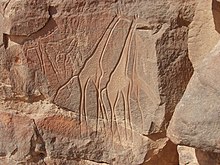 Engraving of giraffes | |
| Location | Wadi al Hayaa, Libya |
|---|---|
| Coordinates | 25°45′48″N12°10′13″E / 25.7634°N 12.1704°E |
| Type | Rock art |
| History | |
| Founded | c. 6000 BC |


Wadi Mathendous is a prehistoric archaeological site in the Mesak Settafet escarpment, located in the southwestern Fezzan region in Libya. It contains many petroglyphs of figures and objects, as well as other rock art. The chiseled animals include elephants, giraffes, aurochs, wildcats, and crocodiles. These rock engravings and cave paintings have been dated to the Neolithic period, around 6000 BC.